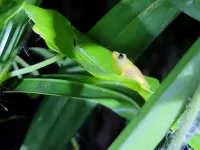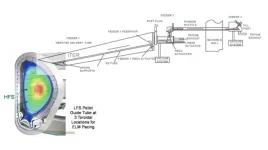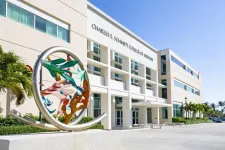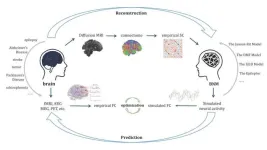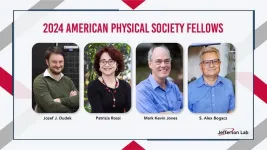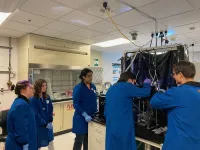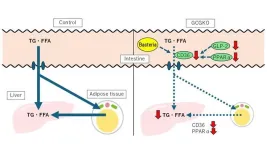The 17 species of coquí frogs, and their signature high-pitched chirp, are considered unofficial mascots of Puerto Rico. The entire population of coquí llanero frogs, the smallest and possibly most endangered of the island’s coquís, is limited to just three small freshwater wetlands on the island’s northern coast. This leaves them vulnerable to major storm events, rising sea-levels, and other changing climate conditions.
“There’s only so much the coquí can do on their own to avoid climate risks,” says Mitch Eaton, lead author of the study and research ecologist for the Southeast Climate Adaptation Science Center. “So, it’s important that we think about how to manage and mitigate risk within this complex ecosystem.”
Modern portfolio theory comes from the field of economics and is a strategy that many of us have likely used to build a stable portfolio of retirement investments. When we make investments, we are participating in financial markets with risk and uncertainty. Modern portfolio theory says that the most stable investment portfolio within this uncertain environment is a combination of assets that respond in opposite ways to changing market conditions. For example, retirement investments are usually a mix of riskier stocks that have higher rewards and more conservative bonds that offer lower returns. How much you invest in stocks versus bonds within that portfolio is determined by how much risk you are willing to take.
But what do retirement accounts have to do with endangered frogs in Puerto Rico?
Natural resource managers also deal in assets and investments. Like the stock market, future environments and climates are uncertain, and managers make investments within this uncertainty, like purchasing parcels of land to place under protection, restoring habitats, and relocating species. In this study, the researchers evaluated whether modern portfolio theory could also be used to identify investment opportunities to help conserve the coquí.
“Diversification of investments is kind of a magic bullet for stability under future market uncertainty,” says Eaton. “The idea behind using modern portfolio theory is to manage risk under future climate uncertainty, and to help managers consider investments more carefully with realistic variables like budget constraints.”
Researchers created models that took into account currently protected habitats, future sea-level rise scenarios, and future precipitation and temperature projections. They also incorporated a range of future funding levels, or rather, different amounts available for managers to invest.
Within this model, the researchers built two portfolio analyses that traded off cost and risk. One portfolio strategy maximized conservation benefits, constrained only by budget levels. The other portfolio strategy traded off potential benefits in favor of lowering risk, but also subject to funding constraints.
Under the benefit maximization strategy, the costs were minimized by investing in relocating frogs to already protected areas. Whereas under the risk-benefit tradeoff strategy, the model prioritized high cost investments of buying new parcels of land specifically to relocate the frogs, resulting in a lower risk of extinction. Using these portfolios, the study found that relying on existing protected areas may not be enough to mitigate future climate risks, and that investing to conserve additional habitats may be worth the cost.
The study also identified possible sites for the frogs on the eastern side of Puerto Rico, which came as a surprise to the researchers since the current distribution of the species is limited to the northern coast. This could offer managers more options to protect the coquí llanero by increasing the geographic footprint of the species.
“Ideally, modern portfolio theory acts as a handy tool for managers that gives them a new way of thinking about how to approach the implementation of management actions over space, in other words, how to pool their investments to manage risk and achieve maximal benefits,” says Eaton.
Modern portfolio theory has many potential applications for species and scenarios beyond the coquí llanero, but there are two important limitations noted in this study. The first is that the current application only considers one species when assessing the competing conservation actions. The other is that applying these high-cost investments into the real world requires more detailed consideration of local conditions like the costs of conservation or restoration of specific parcels. Even so, modern portfolio theory could be applied to a range of species, resource management needs, and uncertain futures.
Learn more about the project: Advancing Climate Change Adaptation Strategies for High Elevation and Endangered Lowland Coquí Frogs in the U.S. Caribbean
Learn more about Southeast Climate Adaptation Science Center: SE CASC
-brondizio-
Note to editors: The study abstract follows.
“Applying portfolio theory to benefit endangered amphibians in coastal wetlands threatened by climate change, high uncertainty, and significant investment risk”
Authors: Mitchell Eaton & Adam Terando, Southeast Climate Adaptation Science Center & U.S. Geological Survey; Jaime Collazo, North Carolina Cooperative Fish and Wildlife Research Unit.
Published: October 7, 2024, Frontiers in Conservation Science.
DOI: 10.3389/fcosc.2024.1444626
Abstract:
The challenge of selecting strategies to adapt to climate change is complicated by the presence of irreducible uncertainties regarding future conditions. Decisions regarding long-term investments in conservation actions contain significant risk of failure due to these inherent uncertainties. To address this challenge, decision makers need an arsenal of tools to help guide spatial conservation strategies. Theory asserts that managing risks can be achieved by diversifying an investment portfolio to include assets that respond inversely to one another under a given set of conditions. We demonstrate an approach for formalizing the diversification of land parcels and conservation actions by using correlation structure to quantify the degree of risk for any proposed management investment. We illustrate a framework for identifying habitat refugia by integrating species distribution modeling, climate scenarios, and changes to critical habitat. Using the plains coqui (Eleutherodactylus juanariveroi), an endangered amphibian known from only three small wetland populations on Puerto Rico’s coastal plains, we evaluate the distribution of potential refugia under two model parameterizations and four sea-level rise scenarios. We apply portfolio theory using two distinct objective functions and eight budget levels to inform investment strategies for mitigating risk and increasing species persistence probability. Models project scenario-specific declines in coastal freshwater wetlands from 2% to nearly 30% and concurrent expansions of transitional marsh and estuarine open water. Conditional on the scenario, island-wide species distribution is predicted to contract by 25% to 90%. Optimal portfolios under a benefit maximization objective function emphasizes translocating frogs to existing protected areas rather than investing in the protection of new habitat. Alternatively, optimal strategies using the second objective function – a risk-benefit tradeoff framework – include significant investment to protect parcels for the purpose of reintroduction or translocation. These findings suggest that leveraging existing protected areas for species persistence, while less costly, may represent excessive risk and could diminish conservation benefits. Although our modeling includes numerous assumptions and simplifications, this framework provides useful inference for exploring resource dynamics and developing robust adaptation strategies using an approach that is generalizable to other conservation problems which are spatial or portfolio in nature and subject to unresolvable uncertainty.
END
